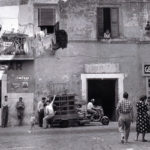A lacerating, monumental work, the novel narrates the story of Ida Mancuso, née Ramundo, a dispossessed woman of Jewish descent and her two sons Antonio (Nino, Ninnarieddu) and Giuseppe (Useppe) born following a rape by a German soldier during and immediately after the Second World War, in Rome. The micro history of this small family becomes a way to give voice to and personalize the lives of anonymous masses, seen as the social and moral casualties in the macro history of WWII.
Another recurring theme is the passionate critique of power dynamics.
In a letter to her friends, the composer Hans Werner Henze, Morante wrote:
“I also hope in the healing of the wounded and their offenders. And to each and every one, I wish to heal not only from the wounds and diseases, but also first of all – from the avidity of power.”
Morante’s La Storia is clearly not a historical novel in the tradition of Manzoni’s The Betrothed, or in the American tradition, Hawthorne’s The Scarlett Letter.
The author is not attempting to describe the individuals and the forces that make historical events happen, but rather focuses on history’s unsung victims, such as Ida, her sons, and most of the characters who populate the novel.
If anything, it is as an uncompromising denunciation of the debris and collateral damage of the historical process, an anarchist’s warning call against the violence of history, written at a time when nuclear annihilation loomed large.
By focusing on the years between 1941-47, with a coda extending into 1967, as a case study of something extending before and after these events, Morante address the totality of what we call history, the history of humanity. She is not simply writing fiction but instead reporting on what has been happening for thousands of years: history as the story of the massacre of innocents who do not know, understand, or make history, but who are its casualties.
In 1975 she told her friend and critic Cesare Garboli:
“I did not intend to write a novel. I wanted to take political action. My novel is a political action.”
La Storia is as all-encompassing as real life. It is a novel of stark contrasts, where parallel to the suffering of people whose ignorance and uniformed fears are unrelenting, there is also what Garboli referred to as a “a heroic, comic-euphoric, and chivalrous tonality.”
The novel takes place in Rome, more precisely in specific neighborhoods of the Italian capital: San Lorenzo, Pietralata, Testaccio, and the former Ghetto. And yet Morante is writing about Europe and perhaps the whole world. Rome was Morante’s home, but most importantly, during those years, the theater of war where the Allies forces fought the Nazi-Fascists while the Vatican passively watched the clash unfold.
What occurred in Rome embodied a transoceanic conflict that shaped the post-war political and social landscape. Alluding to how the events under discussion precede and follow the lives of the protagonists, the novel ends with “… and History continues…” That is to say, the lives of Ida, Useppe and the other characters of the novel have been chosen as emblematic of the disenfranchised and forgotten lives that for centuries have populated the earth, embodying the historical sweep alluded to on the cover as “A scandal that has lasted for ten thousand years.”.



